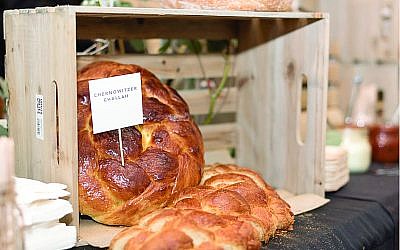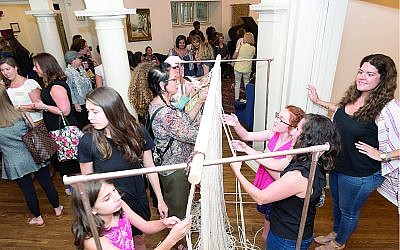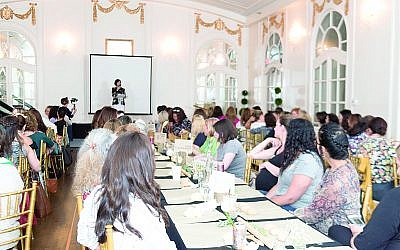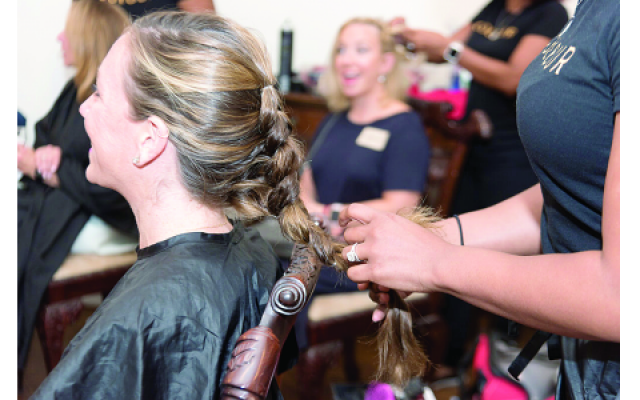Braids, Braids and More Braids
An evening of braiding hair, challah and macrame brought women together before Rosh Hashanah.
What do hair braiding, macramé and challah have in common? They involve weaving, twisting and entwining, and that’s what Jewish women from Atlanta experienced Sept. 4 at a pre-Rosh Hashanah event, “Braids & Braids, For Body and Soul,” sponsored by Chabad Intown.
The women were treated to professional hair braiding, contributed to a community macramé art wall hanging, and sampled more than eight types of challah along with sweet and savory dips.
Dena Schusterman, rebbetzin of Chabad Intown, welcomed the crowd with wisdom from the Jewish month of Elul. And Rochie Pinson, author of “The Rising Life: Challah Baking. Elevated.,” inspired those gathered with her discussion about “rising up.”

Here’s what some of those attending had to say about the event:
“I loved the act of braiding challah with other women, with friends, in the days before Rosh Hashanah,” said Samara Minkin. “It’s a rare Tuesday when you run into women from Sandy Springs, Decatur, Intown, Buckhead, all together for a low-key, relaxed and sweet evening.”
Susan Robinson was impressed by the connection between hair braiding and challah braiding. “It turns out it was the perfect blend of simple fun and meaningfulness.”
For Karen Luscher, having three generations of her family with her made the experience more memorable. “To have my 12-year-old daughter, my mother and myself all leave with the same level of fulfillment is what it’s all about. L’dor v’dor!”

“In life we are asked to rise up in a variety of ways. Sometimes we are able to rise up with lightweight gusto and sometimes we do it with a bit of weight. Listening to the author Rochie Pinson at the Chabad Intown event, I was reminded that the connection of making challah from start to finish is analogous to how we generally rise up in our lives,” Luscher said.
Making the dough is part art and science, with careful care to how the ingredients mix together. Rising up in our every day is also part art and science. Science has proven that happy people with a positive outlook live a healthier, longer life. How we all find happiness is a true art because there are a variety of ways to achieve that state as a standard mode of operating in a given day.
The dough-rising process requires another level of attention and care to nurture the dough through the rising, falling and rising phases. In our given day or time horizon we all have to nurture ourselves through our rising and falling moments. Our care for ourselves and for supporting others during those changes helps define how we leave an imprint on this world.
In challah terms, the next phase is the shaping of the dough into one of a variety of forms, which become an expression of love and encouragement. In life we have multiple ways to shape our “dough.” In our daily lives, we cross, twist, connect and create a shape to our actions, thoughts and words of expression. While there is a set time of how long we bake a challah, the time we devote to nurturing ourselves and the people who cross our pathways will vary, but in the end, all of the time is most successful with intentional care and nurturing.
In her book, “Rising: The Book of Challah,” Pinson greatly links how each of the ingredients and steps of making challah are directly connected to how we live with intention. While I haven’t had a chance to pour a cup of tea and curl up to read the whole cookbook yet, I have taken some sneak peaks into her insights. The one thought that permeated the event and is present in the book is the need to “nurture from the deepest parts of ourselves.” Trying to fit into a “cookie cutter” mold of nurturing will only frustrate and be harmful to both ourselves and our loved ones, cheating them of our full nurturing potential.

To nurture is to be aware of our most true self and to give from that place. We make challah from a place of commitment to nourish ourselves and our families in a way that goes beyond mere physical feeding and watering.
The first letters of the words of the verse: “I am my beloved’s and my beloved is mine” form an acronym for the name Elul. As we are wrapping up the month of Elul, we’ve been called upon to rise up and do the work to reach out to reflect how we have been the beloved so that in Tishrei, Hashem can reply back in the conversation as our beloved. Kabbalah teaches us that in Elul, Hashem is telling us: “I trust you and believe in you. You should step in to nurture yourself to grow stronger and I will be there for you if you do.”
Reach inwards and outwards to nurture the world around you. Your investment will pay off in the long run. Wishing everyone a meaningful new year filled with moments to kneed, shape and rise yourself and those connected to you.




comments